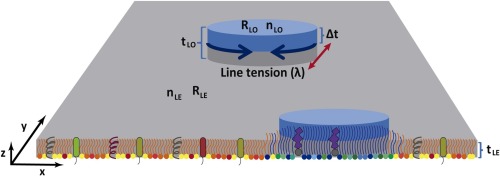Purified myelin membranes (PMM) were spread as monomolecular films at the air/aqueous solution interface, and visualized by Brewster Angle Microscopy (BAM) at different lateral pressures (π“>) on three specific aqueous solutions: absence of salts, physiological conditions and presence of calcium. Coexistence of Liquid-Expanded (LE) and Liquid Ordered (LO) phases persisted up to collapse in the presence of salts, whereas monolayers became homogeneous at π“> ≥ 35−40 mN/m when salts are absent. This PMM phase-mixing behavior in monolayers is similar to the previously reported behavior of PMM multilamellar vesicles. Reflectivities (Rp“>) of p-polarized light from both phases were assessed throughout the whole π“> -range, and film thicknesses (t“>) were calculated from the Rp“> values and measured film refractive indices (n“>). The LO phase was found to be more reflective and thicker than the LE phase at ≤ 15 mN/m, but less reflective and thinner at higher π“> .π“>
We also determined the line tension (λ“>) of PMM monolayers at the domain boundaries from the rate of domain shape relaxation, which turned out to be of the order of picoNewtons () and decreased as π“> increased. A correlation between λ λ“> and thickness differences (Δt“>) was found, suggesting that Δt“> is a molecular determinant for λ“>in PMM monolayers.
Both and Δt“>and Δt“> were found to increase markedly when calcium was present in the subphase. This result corroborates the concept of divalent cations as a stabilizing factor for phase separation, in line with earlier studies on this mixture forming multilamellar membrane arrangements.



